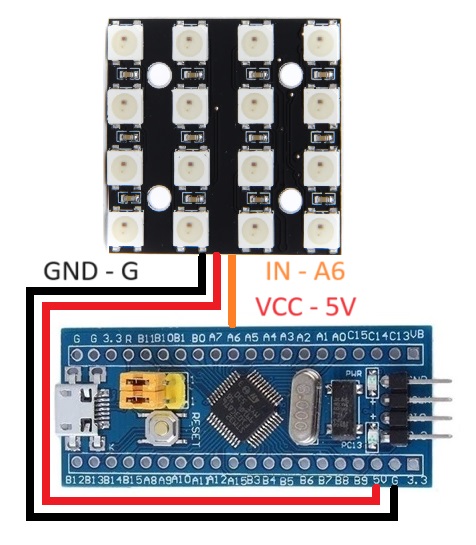Docs
Micro-controllers, wireless transmission and database

WS2812 NeoPixel addressable LED with Blue Pill using STM32CubeIDE
Prerequisites
This project assumes you have already installed STM32CubeIDE. You need to have previously done a basic blink sketch with blue-pill using STM32CubeIDE. I have made a complete video from installing STM32CubeIDE to LED blink program. You can watch it by clicking this link. https://www.youtube.com/watch?v=kXg467nVd_A
Wiring Diagram

Transmitter Module
STM32CubeIDE Settings
Click RCC → High Speed Clock (HSE) to Crystal/Ceramic Resonator
Click Clock Configuration tab → HCLK (MHz) to 72
Click Pinout and Configuration tab
Click Timer → Click TIM3 →
Clock Source set to Internal Clock
Channel1 set to PWM Generation CH1
Configuration → Parameter Settings →
Prescaler set to 30-1
Counter Period 3-1
Click DMA Settings tab Click add button
Select TIM3_CH1 and Select Memory to Peripheral
Keep Data width Half Word
------------- Test Code ------------
uint16_t pwmData[384]; //16*24=384 (No of LEDs 16 and 24 Pulses for each LED) for (int i=0; i<384; i++) pwmData[i] = 2; HAL_TIM_PWM_Start_DMA(&htim3, TIM_CHANNEL_1, (uint32_t *)pwmData, 384); HAL_Delay (10); HAL_TIM_PWM_Stop_DMA(&htim3, TIM_CHANNEL_1); HAL_Delay (500); for (int i=0; i<384; i++) pwmData[i] = 1; HAL_TIM_PWM_Start_DMA(&htim3, TIM_CHANNEL_1, (uint32_t *)pwmData, 384); HAL_Delay (10); HAL_TIM_PWM_Stop_DMA(&htim3, TIM_CHANNEL_1); HAL_Delay (500);
------------- END Test Code ------------
Additional code on top of STM32CubeIDE generated code (main.c)
/* USER CODE BEGIN 0 */ #define noOfLEDs 16 uint16_t pwmData[24*noOfLEDs]; void HAL_TIM_PWM_PulseFinishedCallback(TIM_HandleTypeDef *htim) { HAL_TIM_PWM_Stop_DMA(&htim3, TIM_CHANNEL_1); htim3.Instance->CCR1 = 0; } void resetAllLED (void) { for (int i=0; i<24*noOfLEDs; i++) pwmData[i] = 1; } void setAllLED (void) { for (int i=0; i<24*noOfLEDs; i++) pwmData[i] = 2; } void setLED (int LEDposition, int Red, int Green, int Blue) { for (int i=7; i>=0; i--) // Set the first 8 out of 24 to green { pwmData[24*LEDposition + 7 - i] = ((Green >> i) & 1) + 1; } for (int i=7; i>=0; i--) // Set the second 8 out of 24 to red { pwmData[24*LEDposition + 15 - i] = ((Red >> i) & 1) + 1; } for (int i=7; i>=0; i--) // Set the third 8 out of 24 to blue { pwmData[24*LEDposition + 23 - i] = ((Blue >> i) & 1) + 1; } } void ws2812Send(void) { HAL_TIM_PWM_Start_DMA(&htim3, TIM_CHANNEL_1, (uint32_t *)pwmData, 24*noOfLEDs); } /* USER CODE END 0 */ /* USER CODE BEGIN WHILE */ while (1) { resetAllLED(); ws2812Send(); setLED(0, 255, 0, 0); // Red ws2812Send(); HAL_Delay (500); setLED(1, 0, 255, 0); // Green ws2812Send(); HAL_Delay (500); setLED(2, 0, 0, 255); // Blue ws2812Send(); HAL_Delay (500); setLED(3, 255, 255, 0); // Yellow ws2812Send(); HAL_Delay (500); setLED(4, 0, 255, 255); // Magenta ws2812Send(); HAL_Delay (500); setLED(5, 255, 0, 255); // Cyan ws2812Send(); HAL_Delay (500); resetAllLED(); ws2812Send(); setLED(6, 255, 255, 255); // Specific color ws2812Send(); HAL_Delay (3000); resetAllLED(); ws2812Send(); for (int i=255; i>0; i--) // Set brighness for red (Dimm) { setLED(7, i, 0, 0); ws2812Send(); HAL_Delay (20); } for (int i=0; i<255; i++) // Set brighness for green (Up) { setLED(7, 0, i, 0); ws2812Send(); HAL_Delay (20); } for (int i=255; i>0; i--) // Set brighness for blue (Dimm) { setLED(7, 0, 0, i); ws2812Send(); HAL_Delay (20); } /* USER CODE END WHILE */